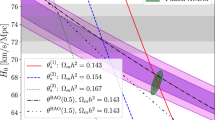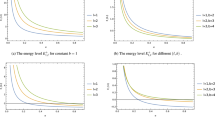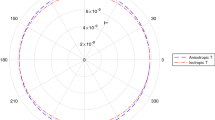Abstract
There has been much interest in the cosmological consequences of line-like topological defects (‘cosmic strings’) which may be produced in a phase transition in the early Universe1–8. Such strings would produce density fluctuations on a broad range of scales and may have been responsible for the formation of galaxies. In view of this possibility, it would be useful to have more direct evidence of the existence of strings than the observed clustering of matter. We show here that cosmic strings would generate anisotropy of the microwave background temperature with a very distinctive feature; the temperature would have steplike discontinuities on curves on the sky. Present anisotropy measurements limit the line density parameter, Gμ to be <10−5. Popular values of this parameter, for the purpose of galaxy formation, are only an order of magnitude below this. The anisotropy that we discuss will exist in addition to that produced by curvature fluctuations due to strings and matter at the time that the Universe becomes optically thin.
This is a preview of subscription content, access via your institution
Access options
Subscribe to this journal
Receive 51 print issues and online access
$199.00 per year
only $3.90 per issue
Buy this article
- Purchase on Springer Link
- Instant access to full article PDF
Prices may be subject to local taxes which are calculated during checkout
Similar content being viewed by others
References
Kibble, T. W. B. J. Phys. A9, 1387–1398 (1976).
Vilenkin, A. Phys. Rev. D23, 852–857 (1981).
Everett, A. E. Phys. Rev. D24, 858–868 (1981).
Vilenkin, A. Phys. Rev. D24, 2082–2089 (1981).
Vilenkin, A. & Shafi, Q. Phys. Rev. Lett. 51, 1716–1719 (1983).
Turok, N. Preprint, Grand Unified Strings and Galaxy Formation (Univ. California, Santa Barbara, 1984).
Turok, N. Preprint, Stretching Cosmic Strings (Univ. California, Santa Barbara, 1984).
Hogan, C. Preprint, Massive Black Holes Generated by Cosmic Strings (Caltech, 1984).
Birkinshaw, M. & Gull, S. F. Nature 302, 315–317 (1983).
Fixsen, D. J., Cheng, E. S. & Wilkinson, D. T. Phys. Rev. Lett. 50, 620–622 (1983).
Gott, J. R. Preprint, Gravitational Leasing Effects of Vacuum Strings: Exact Solutions (Princeton Univ., 1984).
Author information
Authors and Affiliations
Rights and permissions
About this article
Cite this article
Kaiser, N., Stebbins, A. Microwave anisotropy due to cosmic strings. Nature 310, 391–393 (1984). https://doi.org/10.1038/310391a0
Received:
Accepted:
Issue Date:
DOI: https://doi.org/10.1038/310391a0
This article is cited by
-
Space fabric wrinkles: history of observational searches for exotic structures in the Universe
La Rivista del Nuovo Cimento (2021)
-
Modulus D-term inflation
Journal of High Energy Physics (2018)
-
Axially symmetric anisotropic string cosmological models in Saez-Ballester theory of gravitation
Astrophysics and Space Science (2017)
-
Dirac particles tunneling from black holes with topological defects
General Relativity and Gravitation (2016)
-
The Higher Dimensional Gravastars
International Journal of Theoretical Physics (2015)
Comments
By submitting a comment you agree to abide by our Terms and Community Guidelines. If you find something abusive or that does not comply with our terms or guidelines please flag it as inappropriate.



